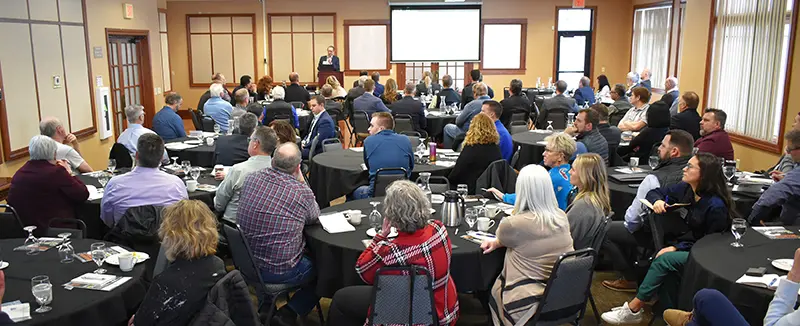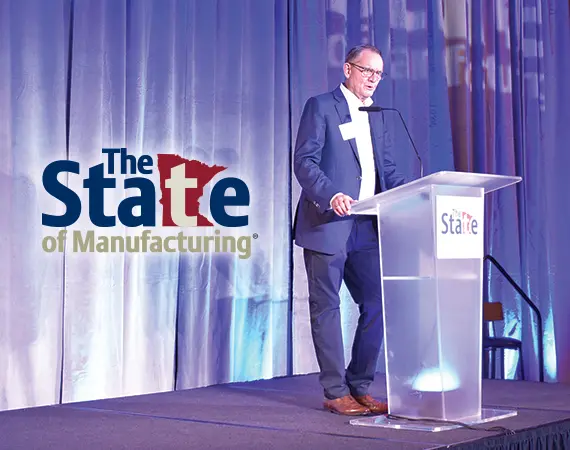As Bob Kill prepares to close out the last regional rollout of Enterprise Minnesota’s 2023 State of Manufacturing® (SOM) survey data, he reflects that his audiences have evolved from passive listeners to motivated advocates who want to use information to improve their local marketplace.
“That’s what we hoped would happen,” he says.
Kill and his colleagues at Enterprise Minnesota launched the State of Manufacturing in 2009 as an annual survey of small- and medium-sized manufacturers across Minnesota. They hoped to use the SOM’s data to connect Minnesota’s manufacturing advocates to create a coalition that would promote how underappreciated manufacturers provide the job-creating economic engine that sustains their home communities. That coalition would include the overall business community, companies that provide goods and services to manufacturers, community activists, and educators.
“Manufacturers at the time got zero credit for providing their communities with stable, well-paying jobs, or passing along economic prosperity to their suppliers of goods and services,” Kill recalls. “It’s fair to say that manufacturers were not represented at all.” He says the vision for this first-in-the-nation project required that the SOM survey data would have unassailable credibility. “We knew that if this was going to succeed at all, the numbers had to be meaningful,” he says. Along with Enterprise Minnesota Vice President of Marketing and Organizational Development Lynn Shelton, his team recruited nationally prominent pollster Rob Autry to oversee the collection of data. Autry and his Charleston-based firm, Meeting Street Insights, were tasked with conducting a statistically valid sample of 400-plus company executives, complemented by up to 14 regional focus groups. The poll data would provide objective data about the marketplace, Kill says, but the focus groups would give subjective reasons about why manufacturers responded the way they did. The focus groups became popular annual regional events in which manufacturers enjoyed sharing their opinions.

The original plan, Kill says, included releasing the data publicly at a significant Twin Cities-based event, followed by up to a dozen events at regional venues.
The SOM’s success has exceeded even the most optimistic expectations, Kill says. Autry, recently named America’s top political pollster, has personally overseen each of the 15 surveys. The official public rollout of data has attracted as many as 500 attendees, and regional events can draw over 100 people.
“Who would have ever thought that 500 people would show up to hear a pollster describe the results of a poll?” Kill asks, adding that he finds the energy in regional events particularly gratifying.
“People aren’t just passively showing up anymore,” he says. “The poll has brought manufacturers to the party who want to expand the power of public-private connections.”
Legislators, he says, increasingly use the poll data to understand how much manufacturers contribute to their districts, especially when combined with plant tours organized by Enterprise Minnesota. “I’ll always wish we had more legislative involvement, but we help show how some regulations can be much more harmful to small manufacturers than a 4,000-employee company.
“That topic was addressed very openly at every one of this year’s regional meetings,” he says.
While the major Twin Cities rollout gives the SOM substantial visibility, he says, regional events bring people together to identify and solve problems locally. “There are significant differences between regions in Minnesota,” Kill says.
“There is extreme interest in how we can apply this (SOM) information to make our communities and regions more attractive to maintain and retain and grow our economies.”
This year’s regional rollouts paid particular attention to the ongoing workforce challenges in Greater Minnesota, Kill says, noting that the SOM data was the first place — 10 years ago — to reveal the potential impact of the impending worker shortage.
“Manufacturers knew what was coming,” Kill says. “And they still do. If you were to listen only to the media, you’d think the workforce issues have gone away,” he adds. “That’s not what we heard in the regional rollouts. People wanted to talk about workable solutions versus just admiring the problem.”
Kill also credits the SOM sponsors, who not only underwrite the considerable costs of the project but also publicize the findings to their own networks. Kill says Enterprise Minnesota carefully crafted industry-specific exclusivity to sponsors so they can “own” the data to their publics.
“Early on, our Platinum sponsors were more interested in helping get the project off the ground,” Kill says. “Now they see the value on their own terms. Our current roster of sponsors is all interested in manufacturing; they use the poll and our events to connect with small- and medium-size manufacturers. And they also see benefits from working with other sponsors.
“We have some wonderful sponsors,” he says.
Return to the Spring 2024 issue of Enterprise Minnesota® magazine.


